Galeria de Mukul Banerjee (www.mukulbanerjee.com)
Hampi & North Karnataka Trip, March 10
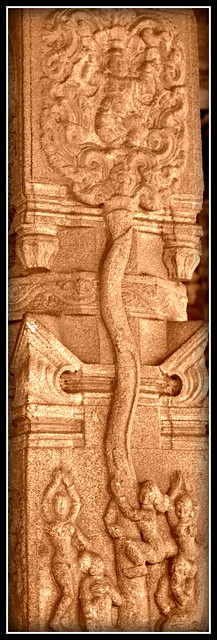
Carving_4

Carving_3
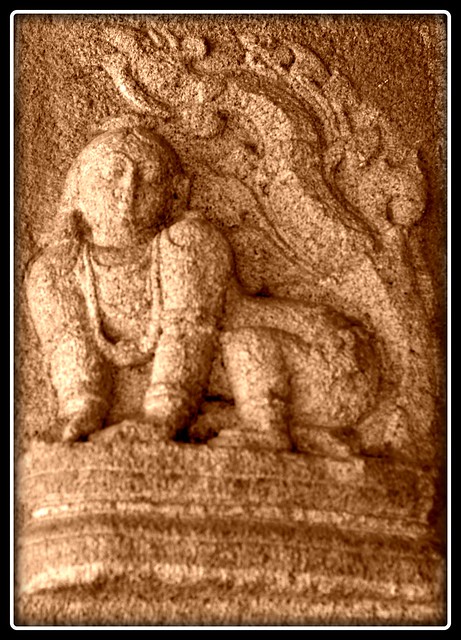
Carving_2
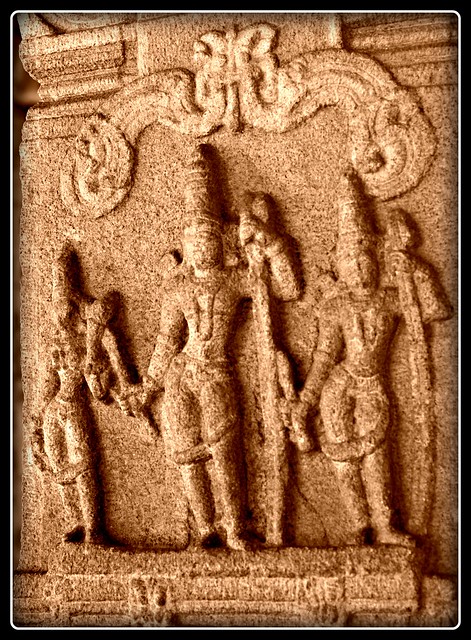
Carving_1
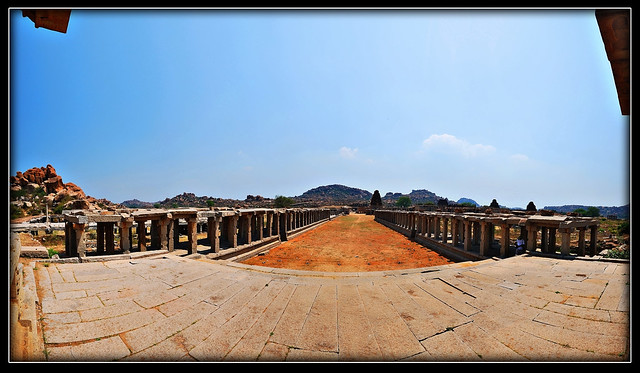
Panorama from Inscribed Vishnu Temple, Hampi
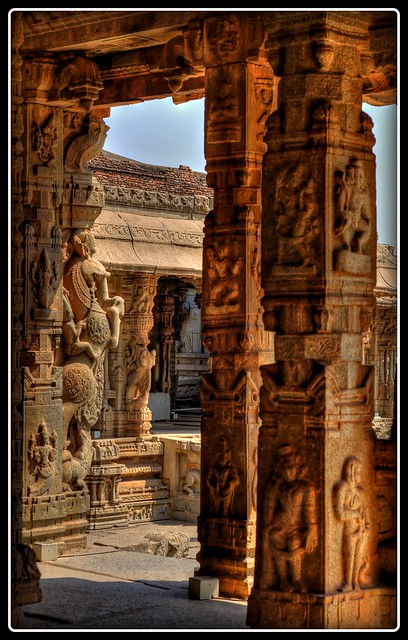
Vittala Temple Pillars, Hampi
Vittala, after whom the temple is known, is a form of lord Vishnu. This aspect of Vishnu was worshiped in this part of the country as their cult deity by the cattle herds.
The temple was originally built in the 15th century AD. Many successive kings have enhanced the temple campus during their regimes to the present form. Yon can even see the remains of a township called Vittalapura that existed around this temple complex. The highlight of Vittala temple is its impressive pillared halls and the stone chariot. The halls are carved with an overwhelming array of sculptures on the giant granite pillars. The stone chariot located inside the campus is almost an iconic structure of Hampi.
One typically accesses the campus through the eastern entrance tower, next to which the ticket counter is located. On entering through this massive tower, the first thing draws your attention would be a series of compact platforms along the central axis of the campus. At the end of these platforms stands the Stone Chariot. This is in fact a shrine built in the form of a temple chariot. An image of Garuda (the eagle god) was originally enshrined within its sanctum. Garuda, according to the Hindu mythology, is the vehicle of lord Vishnu. Thus the Garuda shrine facing the temple’s sanctum is symbolic.
It may appear (and sometimes even referred to) as a monolithic structure. In reality this stone shrine was built with many giant granite blocks. The joints are smartly hidden in the carvings and other decorative features that adorn the Stone Chariot. The chariot is built on a rectangular platform of a feet or so high. All around this base platform is carved with mythical battle scenes. Though the chariot is not resting on it, the four giant wheels attached mimic the real life ones complete with the axis shafts & the brakes. A series of concentric floral motifs decorate the wheels. It appears from the marks on the platform, where the wheels rest, the wheels were free to move around the axis.
You can still see the remains of the painting on the carvings of the chariot. Probably because it was relatively protected from the natural wearing elements, the undercarriage of the chariot spots one of the best preserved specimens of this kind of paintings. It is believed the whole of the Vittala Temple’s sculptures were once beautifully painted in similar fashion using the minerals as medium.
In front of the chariot two elephants are positioned as if they are pulling the chariot. In fact these elephants where brought from elsewhere and positioned here at a later stage. Originally two horses were carved in that position. The tails and the rear legs of the horses can be still seen just behind these elephant sculptures. A broken stone ladder once gave access to the sanctum is kept between the elephants. You can still spot the marks on the floor and the doorsill where once the ladder stood.
On leaving the Stone Chariot you reach the main hall in front of the Vittala temple. This hall though partially damaged is still awe inspiring. Facing the Stone Chariot, a series of steps flanged by elephant balustrades gives access to this elevated open hall called the Maha-Mantapa (the great hall). The balustrades on the east and west porch of this hall is more dramatic with giant lion Yalis fighting the relatively dwarf elephants. The Maha-Mantapa stands on a highly ornate platform. This fluted platform is carved with a series of floral motifs. The lowermost of it is a chain of horses, its trainers and the traders.
The Maha-Mantapa contains four open halls within. The south, north and the east ones are still intact. The central western hall is collapsed, probably due to the arson that followed the fall of the capital.
The main highlight of the Maha-Mantapa is its richly carved giant monolithic pillars. The outermost of the pillars are popularly called the musical pillars. These slender and short pilasters carved out of the giant pillars emit musical tones when tapped. Probably these do not belong to any of the standard musical notes, but the musical tone of the vibes earned it’s the name. Unmindful curiosity of the visitors has damaged many of these pilasters and tapping on it is banned for the sake of preservation.
The eastern hall which is called the musicians hall is notable for sculptures of musicians on the pillars. Each of the pillars surrounding this hall is sculptured with musicians, drummers and dancers.
The southern hall is dominated with the rampant mythical creatures called Yalis. The capitals of each of the pillars branches into heavily ornate corbels with terminating with lotus buds.
The northern hall is surrounded with a series of pillars with the Narasimha (the man-lion incarnation of Vishnu) themes. The most notable ones are that of Narasimha slaying Hiranyakashipu on his lap. Prahlada is seen sitting at the base in a praying posture.
The ceilings of the halls too are of interest with the lotus like carving at the centre.
Further west is a closed hall with two porches on either side. Further ahead is the sanctum.
The inner sanctum is devoid of any idol. A narrow and unlit passageway encircles the inner sanctum. A few steps on either sides of the sanctum’s main door give access to this passage. The outer wall of the sanctum that one can only sees from this passageway is richly decorated with the Kumbha-Pankajas (the motifs where lotus flower flows out of a pot)
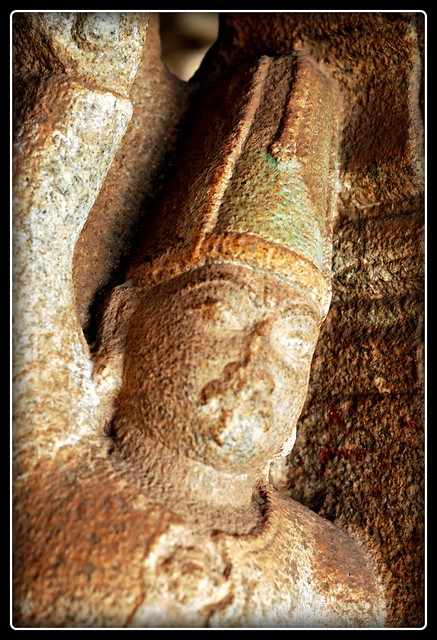
Wall Carvings at Vittala Temple

Wall Carvings at Vittala Temple
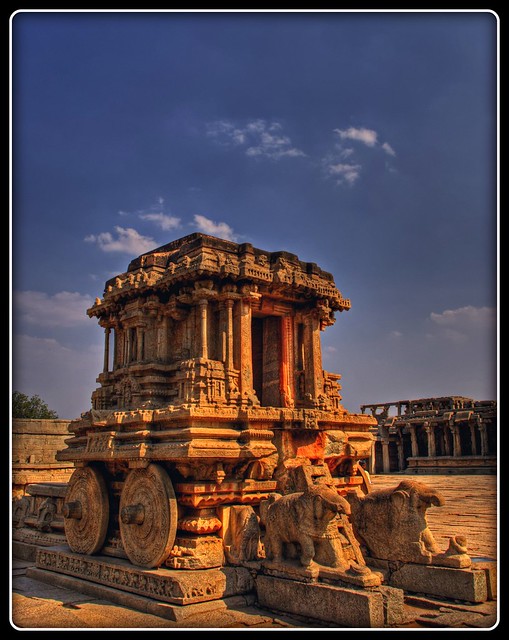
Stone Chariot, Vittala Temple Hampi
At Hampi, the stone chariot located in the Vittala Temple Complex is a shrine built in the form of temple chariot. An image of Garuda was originally enshrined within its sanctum. Garuda, according to the Hindu mythology, is the vehicle of lord Vishnu.
The chariot built with many giant granite blocks. The joints of the blocks are smartly hidden in the carvings that adorn the Stone Chariot and due to this it appears as a monolithic structure. It is built on a feet high rectangular platform. All around this base platform is carved with mythical battle scenes. The four giant stone wheels attached to the chariot look complete with the axis shafts. On the wheels are concentric floral motifs.
In front of the chariot two elephants are positioned as if they are pulling the chariot. These elephants where later additions to the chariot and they actually replaced two horses that were carved in that position. The tails and the rear legs of the horses can be still seen just behind these elephant sculptures. A broken stone ladder once gave access to the sanctum is kept between the elephants.
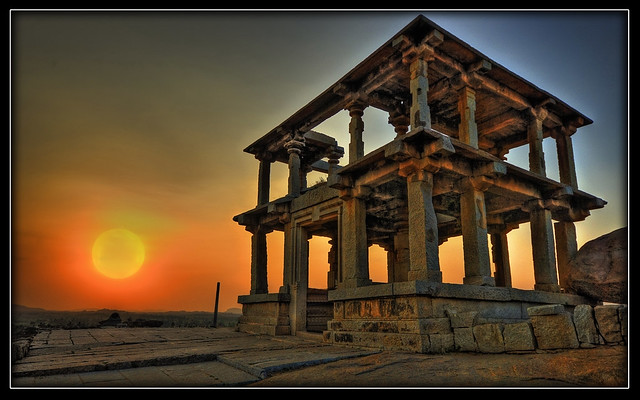
Sunset atop Hemkuntha Hill, Hampi
| |||
| Accueil |Pensées Du Jour | | Galleries | La Bhagavad-gita Telle Qu'elle Est |
| | Le Cours Ultime de la Réalisation du Soi (tm) | | |
| Obtenez la miséricorde spéciale de Krishna en faisant du service de dévotion Aidez Sankarshan Prabhu dans sa mission de répandre la conscience de Krishna partout dans le monde. Une contribution singulière ou mensuelle peut se faire en ligne en allant ici : | Un appel pour votre assistance Sur l’ordre de son maître spirituel, Srila Prabhupada, Sankarshan Prabhu à dédié sa vie au travail extrêmement urgent de répandre la conscience de Krishna partout dans le monde. Le plus la conscience de Krishna se répand, le plus que la souffrance, le manque et la haine sur cette planète seront remplacés par la félicité, l’abondance et l’amour. Voici une opportunité dorée de faire le plus grand bien pour toutes les entités vivantes et de recevoir les bénédictions spéciales du Seigneur. Par conséquent, nous devons, au mesure du possible, sacrifier notre temps, notre énergie et nos ressources pour aider Sankarshan Prabhu dans son travail urgent. Si vous voulez participer d’une façon ou d’une autre, grande ou petite, veuillez écrire à Sankarshan Prabhu en cliquant si dessous : Envoyer un courriel à Sankarshan Prabhu
| de Sankarshan Prabhu |
2008
LA PENSÉE DU JOUR - Septembre 2008
LA PENSÉE DU JOUR - Aout 2008
LA PENSÉE DU JOUR - Juillet 2008
LA PENSÉE DU JOUR - Juin 2008
LA PENSÉE DU JOUR - Avril 2008
LA PENSÉE DU JOUR - Mars 2008
LA PENSÉE DU JOUR - Fevrier 2008
LA PENSÉE DU JOUR - Janvier 2008


TABLA - FUENTES - FONTS
SOUV2
- SOUV2P.TTF - 57 KB
- SOUV2I.TTF - 59 KB
- SOUV2B.TTF - 56 KB
- SOUV2T.TTF - 56 KB
- bai_____.ttf - 46 KB
- babi____.ttf - 47 KB
- bab_____.ttf - 45 KB
- balaram_.ttf - 45 KB
- SCAGRG__.TTF - 73 KB
- SCAGI__.TTF - 71 KB
- SCAGB__.TTF - 68 KB
- inbenr11.ttf - 64 KB
- inbeno11.ttf - 12 KB
- inbeni11.ttf - 12 KB
- inbenb11.ttf - 66 KB
- indevr20.ttf - 53 KB
- Greek font: BibliaLS Normal
- Greek font: BibliaLS Bold
- Greek font: BibliaLS Bold Italic
- Greek font: BibliaLS Italic
- Hebrew font: Ezra SIL
- Hebrew font: Ezra SIL SR
Disculpen las Molestias

Sankarshan Das Adhikari - ANUAL
Conceptos Hinduistas (1428)SC
Aa-Anc · Aga - Ahy · Ai - Akshay · Akshe - Amshum · Ana - Ancie · Ang - Asvayu · Ata - Az · Baa-Baz · Be-Bhak · Bhal-Bu · C · Daa-Daz · De · Dha-Dry · Du-Dy · E · F · Gaa-Gayu · Ge-Gy · Ha-He · Hi-Hy · I · J · K · Ka - Kam · Kan - Khatu · Ki - Ko · Kr - Ku · L · M · N · O · P · R · S · Saa-San · Sap-Shy · Si-Sy · Ta - Te · U · V · Ve-Vy · Y · Z
Conceptos Hinduistas (2919) SK
Aa-Ag · Ah-Am · Ana-Anc · And-Anu · Ap-Ar · As-Ax · Ay-Az · Baa-Baq · Bar-Baz · Be-Bhak · Bhal-Bhy · Bo-Bu · Bra · Brh- Bry · Bu-Bz · Caa-Caq · Car-Cay · Ce-Cha · Che-Chi · Cho-Chu · Ci-Cn · Co-Cy · Daa-Dan · Dar-Day · De · Dha- Dny · Do-Dy · Ea-Eo · Ep-Ez · Faa-Fy · Gaa-Gaq · Gar-Gaz · Ge-Gn · Go · Gra-Gy · Haa-Haq · Har-Haz · He-Hindk · Hindu-Histo · Ho-Hy · Ia-Iq · Ir- Is · It-Iy · Jaa- Jaq · Jar-Jay · Je-Jn · Jo-Jy · Kaa-Kaq · Kar-Kaz · Ke-Kh · Ko · Kr · Ku - Kz · Laa-Laq · Lar-Lay · Le-Ln · Lo-Ly · Maa-Mag · Mah · Mai-Maj · Mak-Maq · Mar-Maz · Mb-Mn · Mo-Mz · Naa-Naq · Nar-Naz · Nb-Nn · No-Nz · Oa-Oz · Paa-Paq · Par-Paz · Pe-Ph · Po-Py · Raa-Raq · Rar-Raz · Re-Rn · Ro-Ry · Saa-Sam · San-Sar · Sas-Sg · Sha-Shy · Sia-Sil · Sim-Sn · So - Sq · Sr - St · Su-Sz · Taa-Taq · Tar-Tay · Te-Tn · To-Ty · Ua-Uq · Ur-Us · Vaa-Vaq · Var-Vaz · Ve · Vi-Vn · Vo-Vy · Waa-Wi · Wo-Wy · Yaa-Yav · Ye-Yiy · Yo-Yu · Zaa-Zy






No hay comentarios:
Publicar un comentario